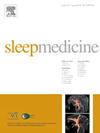Interim analysis of a post-authorization safety study of pitolisant in treating narcolepsy: A real-world European study
IF 3.8
2区 医学
Q1 CLINICAL NEUROLOGY
引用次数: 0
Abstract
Background
Narcolepsy is a chronic sleep disorder characterized mainly by excessive daytime sleepiness (EDS) and cataplexy in the case of narcolepsy type 1 (NT1). Pitolisant is a histamine 3 receptor antagonist/inverse agonist that reduces EDS and cataplexy in patients with narcolepsy.
Methods
We performed a prospective 5‐year follow‐up, non‐interventional study of adults with NT1 and NT2 receiving pitolisant. The primary objectives were to collect information on the long-term safety of pitolisant and analyze the utilization patterns of pitolisant. The secondary objectives were to assess clinical benefit, adherence, impact on patients’ quality of life, disease burden, and patient satisfaction. We reported the results of an interim analysis after 42.6 months.
Results
The population comprised 370 patients (mean age, 40 ± 15 years; 51.4 % women; NT1, 71.4 %; NT2, 28.6 %); 364 received ≥1 dose of pitolisant. Data were available for 356 patients (97.8 %).
Most patients (68.4 %) had ≥1 comorbidity (obesity [BMI≥30], 31.9 %; neuropsychiatric, 31 %; and cardiovascular, 22.8 %). Forty-eight patients (13.2 %) had received no prior narcoleptic treatment, while 98 (31 %) were taking a previous therapy, which was switched to pitolisant. Treatment was combined with pitolisant in 218 (69 %) patients. Pitolisant was discontinued by 131 patients (35.4 %), mainly for safety reasons (14.3 %), lack of response (8.7 %), and patient decision (7.6 %). Overall, 355 treatment-emergent adverse events (3 serious) were reported by 156 patients (42.9 % of safety population), with 218 possibly treatment-related (61.4 %) in 109 patients (29.9 %). Improvements were observed in EDS, cataplexy, and quality of life.
Conclusions
Pitolisant was generally safe and well tolerated in patients with NT1 and NT2 and can be used in both types. Improvements were found in EDS, cataplexy, and quality of life, with good adherence and satisfaction.
求助全文
约1分钟内获得全文
求助全文
来源期刊

Sleep medicine
医学-临床神经学
CiteScore
8.40
自引率
6.20%
发文量
1060
审稿时长
49 days
期刊介绍:
Sleep Medicine aims to be a journal no one involved in clinical sleep medicine can do without.
A journal primarily focussing on the human aspects of sleep, integrating the various disciplines that are involved in sleep medicine: neurology, clinical neurophysiology, internal medicine (particularly pulmonology and cardiology), psychology, psychiatry, sleep technology, pediatrics, neurosurgery, otorhinolaryngology, and dentistry.
The journal publishes the following types of articles: Reviews (also intended as a way to bridge the gap between basic sleep research and clinical relevance); Original Research Articles; Full-length articles; Brief communications; Controversies; Case reports; Letters to the Editor; Journal search and commentaries; Book reviews; Meeting announcements; Listing of relevant organisations plus web sites.
 求助内容:
求助内容: 应助结果提醒方式:
应助结果提醒方式:


